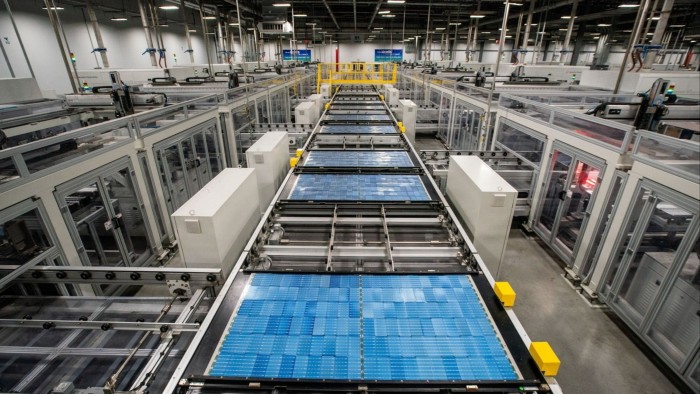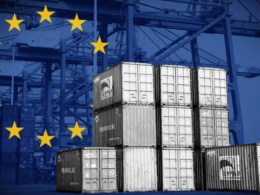Welcome to Energy Source, coming to you from New York.
Markets were buoyed yesterday by news that Jay Powell’s job is safe, after Donald Trump said on Tuesday that he had “no intention” of firing the Federal Reserve chair.
But skittishness over possible Opec+ production increases and a global economic slowdown are weighing on crude oil. Despite a recent recovery to $67 a barrel, prices remain $8 under pre-liberation day tariffs levels.
As Trump cracks down on renewable energy, my colleague Attracta Mooney reports that business leaders are holding fast. According to interviews with 1,500 C-suite executives from 15 countries, nearly half are planning on moving their operations in the next five years to better access renewable energy sources, and nearly all backed a long-term shift away from fossil fuels.
Meanwhile Malcolm Moore, Costas Mourselas and Oliver Barnes reported that Elliott Management is pressuring BP to cut spending to increase its free cash flow up by an extra 40 per cent, as the activist investor increased its stake in the British energy group to more than 5 per cent.
In today’s Energy Source we dive into a report assessing the state of supply chains for solar, wind, batteries and electric vehicles — clean energy technologies boosted by Joe Biden’s Inflation Reduction Act. The research comes as Republicans consider which aspects of the former US president’s landmark infrastructure bill to slash or leave intact. It highlights the key components which are falling behind, and in some cases, keeping pace with projected demand.
Thanks for reading, Martha
US clean energy manufacturing stalls as Republicans take aim at IRA
The Inflation Reduction Act was fated to kick off a new era in US manufacturing, drawing together the country’s efforts to decarbonise and secure its energy supply chains.
Since the bill was enacted in the third quarter of 2022, investments in clean energy technologies have totalled $115bn, a nearly 450 per cent increase from the same period before.
But the production of crucial components of renewable energy sources such as wind and solar is falling behind projected demand — as the sector faces obstacles from tariffs, a hazy policy environment and troubled macroeconomic outlook — according to a new report released this morning from Rhodium Group, an energy and economics research outfit.
In the first quarter of 2025, six announced projects representing $6.9bn of investment were cancelled. This is the highest quarterly investment cancellation on record.
New announced manufacturing commitments were also down nearly a quarter year over year.
The report is the latest portent that the gains from the IRA could stall as the Trump administration prioritises fossil fuels. On Tuesday, US energy secretary Chris Wright called clean energy tax credits “a big mistake”.
The fate of those tax credits, such as the Section 45X Advanced Manufacturing Production Credit — which subsidises the production of solar, wind and battery components — hangs in the balance as Republicans devise their budget plan.
“Companies are considering that when they think about whether they want to make new investments in manufacturing capacity on US soil,” said Hannah Hess, an associate director with Rhodium Group’s energy and climate practice. “There’s the manufacturing tax credit, the linked tax credits that are helping people deploy these technologies and consumer tax credits to help you put solar panels on your roof, which act as demand signals.”
The report looks at four low-carbon technologies — solar, wind, batteries and electric vehicles — and compares announced domestic manufacturing capacity against a range of anticipated 2030-35 demand projections, from a high emissions to low emissions scenario.
Rhodium Group projects that the US will add 58-181 gigawatts of solar capacity from 2030-35. These facilities could produce 19 to 61 per cent of the polysilicon and only 7 to 23 per cent of 2035 demand.
The picture for downstream solar is brighter. In a high emissions situation, cell and module production would meet annual deployment levels. But in a low emissions scenario, cell and module production would meet 35 per cent and 55 per cent of 2035 deployment levels, respectively.
Investment in wind hit a post-IRA low of $5mn in the first quarter of 2025. A new blade manufacturing facility will add 1GW of capacity, along with two wind tower plants adding 0.75GW of combined capacity.
Production of wind nacelles would be 10 per cent short of projected demand in the 2030-35 low emissions scenario but exceed the limited clean energy outcome by 27 per cent.
However, blade production capacity in 2035 would only amount to 26 per cent and 36 per cent of projected deployment in the low and high emission scenarios, respectively, while tower manufacturing capacity would meet 46 per cent and 65 per cent in the two scenarios.
“Things are looking a little stagnant in the wind industry,” said Hess. “That could be companies reading from Trump administration statements and policy actions that there doesn’t seem to be a huge appetite for new, especially offshore wind development, then tailoring their plans for new manufacturing accordingly.”
However, the report does identify green shoots in battery and electric vehicle manufacturing.
Despite high-profile cancellations in the first quarter, including Freyr Battery — which recently rebranded to T1 Energy — calling off plans to build a $2.6bn cell manufacturing plant in Georgia, batteries account for 69 per cent of all cleantech manufacturing investment in the US since the IRA’s enactment. Domestic capacity already exceeds demand for EV batteries and stationary storage.
The facilities under construction will add 656 gigawatt hours of cell capacity and 560 GWh of module capacity by 2035, on top of a further announced 112 GWh of cells and 93 GWh of modules.
If these announced projects come to fruition, cell and module capacity would exceed domestic demand in the high emissions scenario by 81 per cent and 98 per cent in the low emissions scenario.
“Battery manufacturing was the winner of the onshoring efforts, and the scale of capacity is much closer to meeting demand than solar and wind,” said Milo McBride, of the Carnegie Endowment for International Peace.
“The caveat, though, is that some battery materials, as well as chemicals, are still not fully onshored.”
Rhodium projects US sales of 10mn-11mn EVs between 2030-35, way ahead of the current production capacity level of 2.58mn vehicles.
The ability to build out capacity will depend on shaky demand and an uncertain policy environment ameliorating. (Martha Muir)
Data visualisation by Stephanie Stacey
Job moves
Power Points
-
The London Metal Exchange is drawing up plans for a so-called green premium on metals that are mined sustainably.
-
Ministers are set to restrict Britain’s new state-owned energy company from using any solar panels linked to Chinese slave labour.
-
ExxonMobil defeated an attempt by rival Occidental Petroleum to contest its production rights on one of the largest lithium deposits in the US.
Energy Source is written and edited by Jamie Smyth, Martha Muir, Alexandra White, Tom Wilson and Malcolm Moore, with support from the FT’s global team of reporters. Reach us at energy.source@ft.com and follow us on X at @FTEnergy. Catch up on past editions of the newsletter here.
Recommended newsletters for you
Moral Money — Our unmissable newsletter on socially responsible business, sustainable finance and more. Sign up here
The Climate Graphic: Explained — Understanding the most important climate data of the week. Sign up here
Source link









